Programs & Events
Programs & Events
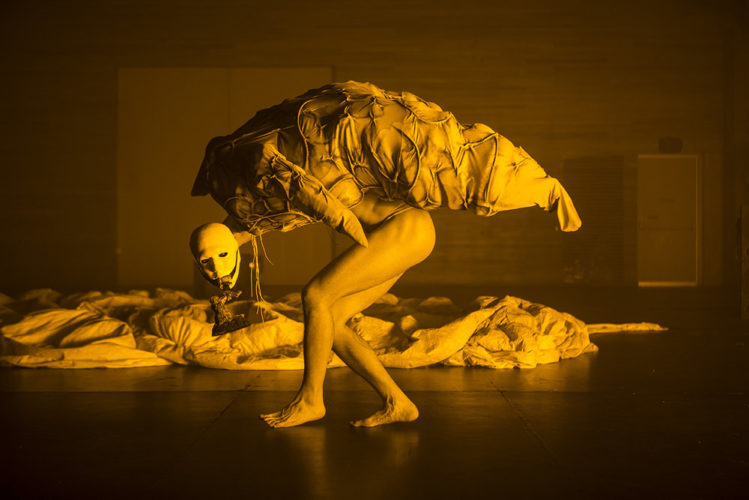
Justin Shoulder, Carrion (still), 2017, performance. Courtesy of the artist.
Join Justin Shoulder for a lecture-performance illuminating Phasmahammer, an ecology of alter personae in their main body of work based on queered ancestral myths. Shoulder’s artwork and performances use avatar as personae, concentrating specifically on movement language in order to enact new kinds of storytelling drawn from the queer club experience, and communal re-imaginings as a way of crafting and enacting new narratives.
This talk is in conversation with Henry Heng Lu, Curator of Centre A.
This program is co-presented with the Vancouver Art Gallery.
Friday, August 7, 2020, 5:30 PM PST via Zoom
Register HERE.
ABOUT THE ARTIST
PHASMAHAMMER is the pseudonym of shape-shifting artist Justin Talplacido Shoulder. Working primarily in performance, sculpture, video and collective events Phasmahammer is an eco-cosmology of alter personas based on queered ancestral myth. Creatures birthed are embodied through handcrafted costumes and prosthesis and animated by their own gestural languages. The artist uses their body and craft as an instrument of metaphysics towards a queer Filipinx futurism. P.H. believes in performance and shared ceremony as communal medicine for difficult times.
P.H. is a founding member of queer artist collective The Glitter Militia (Monsta Gras, Pink Bubble) with partner and key collaborator Matthew Stegh and Club Ate with collaborator Bhenji Ra. Their works have been presented across Australia and Internationally where they work between gallery, nightclub, theatre and cinema contexts. Recent performance highlights include: La Manutention performance artist in residence at the Palais de Tokyo, Paris 2019, The Prague Quadrennial of Stage Design, 2019, Premiere of theatre work Carrion, Performance Space, Sydney (AUS) + subsequent tour to Artshouse, Melb (AUS), Fusebox Festival, Texas (USA), Museum Macan, Jakarta (IDN), Roskilde (DEN), M+ (HK), Singapore Art Museum (SGD), and Asia Pacific Triennial 8 GOMA (AUS).
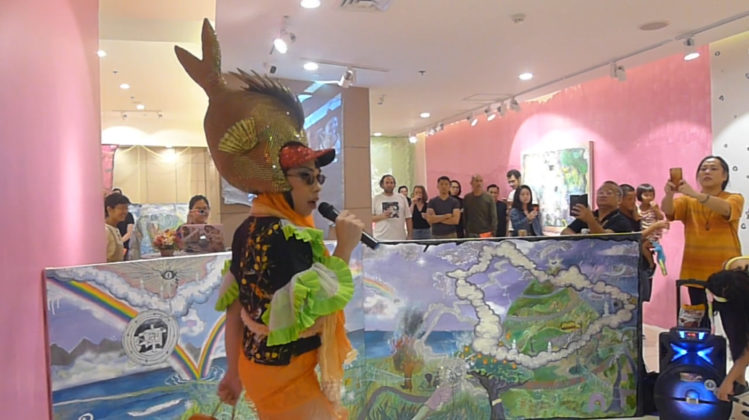
Martin de Mesa, Madam Bwakeva is Venus: A Touch By Touch Performance (still), 2018 – 2020, video. Courtesy of the artist.
Borrowing a term from both navigation and research methods in social science that employ multiple points of view, Triangulations by Pacific Crossings offers three online propositions with artists and curators in Hong Kong, Beijing and Manila, encompassing shared concerns germane to the pandemic and locational contexts. Produced as part of Pacific Crossings in partnership with Centre A: Vancouver International Centre for Contemporary Asian Art, Nanaimo Art Gallery, and Richmond Art Gallery, Triangulations is a coordinated effort to bring forward distinct perspectives from different regions through digital means to support empathy and to cultivate shared understandings about what the future may hold for the arts sector and for the public.
PART III: Dispatches From Manila
An online screening of short video works selected by Lost Frames, a short story by an unnamed artist, and an interview between Allison Collins (Pacific Crossings), Mayumi Hirano and Mark Salvatus (Load na Dito)
July 30 – August 13, 2020
Watch HERE.
Dispatches From Manila asks artists and curators from the region to ‘check-in’, offering perspectives or creative projects that they have been occupied with during the recent months. Metro Manila has been in various types of lockdown since early March 2020, when measures to restrict movement were taken to prevent the spread of disease. With the COVID crisis unfolding among its citizens, governing officials have used the pandemic as a pretense to impose military and police enforcement around the National Capital Region, inciting fear through forms of restriction that echo previous eras of forced civic containment under Martial Law.
Resistant voices among artists in the community, balanced with considerations of safety circulate messages of critique, humourous resistance, and creative forms of virtual comfort. Dispatches relays perspectives of members of the Manila community. The trail of connections reveals a rhizomatic network of solidarity and support.
The program unfolds in three parts:
Programmed by Lost Frames, this virtual screening follows the collective’s regular format of a community screening of short videos selected in an open call. Deliberately ‘anti-curatorial,’ Lost Frames focuses their energies on artist’s recent works and perspectives, emphasizing sharing and feedback over framing devices.
Some works will screen in Tagalog or other local dialects, without translation.
Between the Corpse and the Tree
Remaining anonymous for reasons of safety, this story by an unnamed artist unfolds as a spectral life of palpable fear lived under a militarized state. Drawn from lived experience, both remembered and imagined, the narrator’s account relays the dark atmosphere created by the extreme force that state-sanctioned violence exerts on the lived realities of Filipino citizens.
Following their residency with Pacific Crossings in Vancouver in May 2019, this interview asks Load na Dito’s Mayumi Hirano and Mark Salvatus to elaborate on how their projects continue to unfold under the present circumstances of COVID-19.
ABOUT THE PARTICIPANTS
Lost Frames is a community-based initiative for viewing experimental moving image works in the Philippines, organized by a small group based in Manila. As an in-person event, Lost Frames encourages individuals to share their process and to speak about each other’s methods and ideas. This online screening program presents a selection of artists’ videos from the Philippines.
Load na Dito is a mobile art site that explores creative energies generated and circulated through interactions of individuals, objects, images and ideas. It creates spatio-temporal situations that address issues of participation and problematize the potential of collective production. Load na Dito was initiated by Mayumi Hirano and Mark Salvatus in 2016.
For information about PART I and PART II, please visit centrea.org/pacific-crossings.
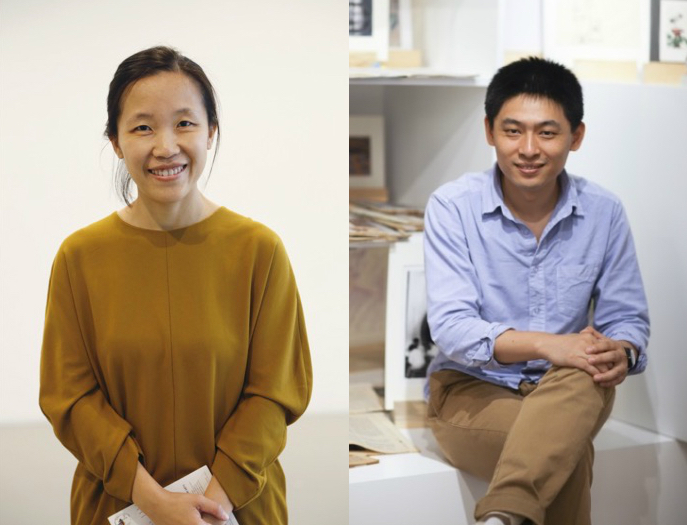
Borrowing a term from both navigation and research methods in social science that employ multiple points of view, Triangulations by Pacific Crossings offers three online propositions with artists and curators in Hong Kong, Beijing and Manila, encompassing shared concerns germane to the pandemic and locational contexts. Produced as part of Pacific Crossings in partnership with Centre A: Vancouver International Centre for Contemporary Asian Art, Nanaimo Art Gallery, and Richmond Art Gallery, Triangulations is a coordinated effort to bring forward distinct perspectives from different regions through digital means to support empathy and to cultivate shared understandings about what the future may hold for the arts sector and for the public.
PART II: Let Individuals Represent Individuals
A talk with Carol Yinghua Lu and Liu Ding
Organized by Henry Heng Lu
Interpreted by Yun-Jou Chang
Response by Su-Ying Lee
Thursday, June 18, 2020, 7 PM PST (Vancouver local time)
Register HERE.
Through Beijing-based Carol Yinghua Lu and Liu Ding’s own daily conversations and their contributions to “Letters Against Separation” on e-flux conversations (https://conversations.e-flux.com/t/letters-against-separation-liu-ding-liu-qingshuo-and-carol-yinghua-lu-as-a-family-in-beijing/9699), they have had a chance to reflect on the impacts of COVID-19, not just on the everyday life in a practical way but on their conception of the existing orders of organization that condition our lives. They have observed a general overdependence and almost blind trust on larger structures, systems and framework of thinking as well as a universal abstraction of individual positions, conditions and subjectivities. The rhetoric around COVID-19 has pivoted on politics and its problematic, yet they argue that politics can only represent and emulate an abstract form of the society consisting of countless individuals, but not actual individuals.
The talk will be followed up by a written response by Toronto-based curator Su-Ying Lee, which will be published by Pacific Crossings at a later date.
ABOUT THE SPEAKERS
Liu Ding is a Beijing-based artist and curator. He has participated in international biennials and triennials such as Istanbul Biennial (2015), Asia Pacific Triennial (2015), Shanghai Biennale (2014), Prospect.3 New Orleans (2014), Taipei Biennial (2012), the Venice Biennale (2009), Seoul Mediacity Biennale (2008), and Guangzhou Triennial (2005). His works have been presented in many art institutions and museums across the world.
Carol Yinghua Lu is an art critic and curator. She is a Ph.D. candidate in art history at the University of Melbourne and director of Beijing Inside-out Art Museum. She is a contributing editor at Frieze and is on the advisory board of The Exhibitionist.
As a curatorial team, Liu Ding and Carol Yinghua Lu have curated Liberation (2010); Little Movements: Self-practice in Contemporary Art I\II\III (2011, 2013, 2015); The 7th Shenzhen Sculpture Biennale (Accidental Message: Art is Not a System, Not a World) (2012), From the Issue of Art to the Issue of Position: Echoes of Socialist Realism (2014), New Measurement and Qian Weikang: Two Case Studies in Early Chinese Conceptual Art (2015), Salon Salon: Fine Art Practices from 1972 to 1982 in Profile—A Beijing Perspective (2015) and Factories, Machines, and the Poet’s Words: Echoes of the Realities in Art (2019). Their ongoing practice of exhibition and publication making establishes organic connections between history and the contemporary, investigates and narrates historical realities from multiple perspectives. They intend to generate narratives of the subjectivity in Chinese art from a diversity of entry points, related closely to the intellectual tradition in China.
For information about PART I and PART III, please visit centrea.org/pacific-crossings.
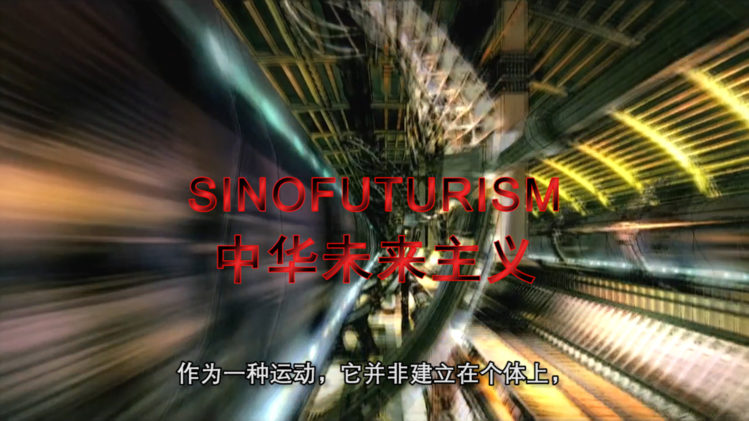
Lawrence Lek, Sinofuturism (1839–2046 AD) (still), 2016. Courtesy of the artist.
Sinofuturism (1839–2046 AD)
Screening & Artist Talk with Lawrence Lek
Saturday, June 6, 2020, 3 PM PST / 6 PM EST
Artist/Curator talk immediately after screening facilitated by VAC Curator Matthew Kyba and Centre A Curator Henry Heng Lu.
Screening is 1 hour, starting at 3 PM PST / 6 PM EST
Artist talk at 4:15 PM PST / 7:15 PM EST
Online via Zoom, sign up HERE.
Centre A and The Visual Arts Centre of Clarington are pleased to present Lawrence Lek’s Sinofuturism (1839–2046 AD) (2016), an experimental video essay on a future seemingly (re-)positioned by China’s technological development through science fiction, documentary melodrama, social realism, and Chinese cosmologies, un-mirroring cultural clichés. Lek’s video reconciles our latent fears of technology-dominated futures with a human-oriented sociological view. Lek presents an overarching report on contemporary Chinese realities as it relates to Asiatic stereotypes, including computing, copying, gaming, studying, addiction, labour, and gambling. The work weaves in disarming commentary about the embedded and overarching digital domination of our current 21st century, blurring the boundaries between science fiction and fact. There will be an artist and curator talk immediately after the conclusion of the film.
ABOUT THE ARTIST
Lawrence Lek is an artist, filmmaker, and musician who unifies diverse practices—architecture, gaming, video, and fiction—into a continuously expanding cinematic universe. His works include the feature-length CGI film ‘AIDOL’ (2019), the video game ‘Unreal Estate: The Royal Academy is Yours’ (2015), the video essay ‘Sinofuturism (1839-2046 AD)’ (2016), the AI-coming-of-age story ‘Geomancer’ (2017), and ‘Nøtel’, a simulation of a fully-automated luxury hotel in collaboration with Kode9 (ICA, London; Art Basel). As a musician, Lek composes soundtracks and conducts live audio-visual mixes of his works, often incorporating live playthroughs of his open-world games. His most recent release is Temple OST, the soundtrack to a site-specific installation at 180 The Strand, London (The Vinyl Factory 2020).
Website: www.lawrencelek.com
SoundCloud: www.soundcloud.com/lawrencelek
Vimeo: www.vimeo.com/lek
#lawrencelek
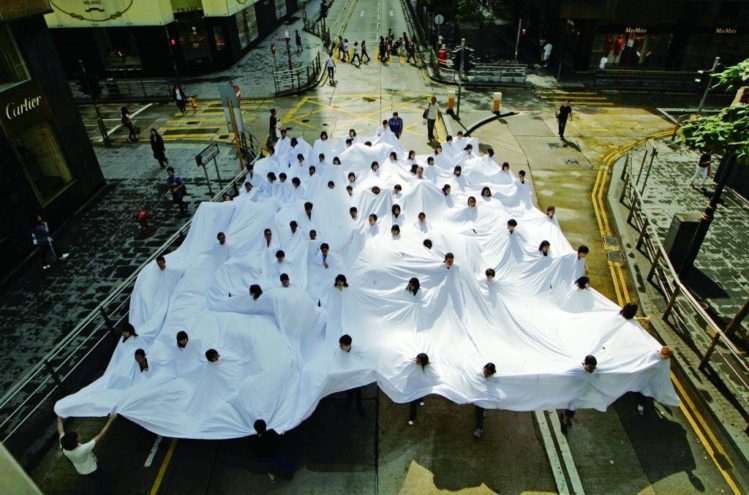
Lygia Pape, Divisor (1968 – 2013), photograph and façade print of a street performance, performed in Central, Hong Kong, 2013. Courtesy of the artist.
Borrowing a term from both navigation and research methods in social science that employ multiple points of view, Triangulations by Pacific Crossings offers three online propositions with artists and curators in Hong Kong, Beijing and Manila, encompassing shared concerns germane to the pandemic and locational contexts. Produced as part of Pacific Crossings in partnership with Centre A: Vancouver International Centre for Contemporary Asian Art, Nanaimo Art Gallery, and Richmond Art Gallery, Triangulations is a coordinated effort to bring forward distinct perspectives from different regions through digital means to support empathy and to cultivate shared understandings about what the future may hold for the arts sector and for the public.
PART I: Revisiting A Journal of the Plague Year on the Eastern Pacific Coast
A talk with Cosmin Costinas and Inti Guerrero
Organized by Jesse Birch
Response by Charlotte Zhang
Wednesday, May 27, 2020, 7 PM PST (Vancouver local time)
Register HERE.
The exhibition, A Journal of the Plague Year, originally responded to disparate narratives of 2003 in Hong Kong—the SARS epidemic, the first arrivals of mainland Chinese on individual tourist visas, and the beginning of the democracy movement, as well as the death of pop culture figure and pan-Asian icon Leslie Cheung, the exhibition traced the fears of disease and fears of other people, both colonial and recent, and the political and pop-cultural watersheds that have shaped Hong Kong identity in the years since. These themes have come back with renewed strength in the recent months of the COVID-19 crisis, with a similar profile of fear grappling our collective imagination. For this special Pacific Coast presentation, curators Cosmin Costinas and Inti Guerrero will focus on the 2015 version of A Journal of the Plague Year held at Kadist Art Foundation in San Francisco. As noted in the press release for San Francisco version of the exhibition:
California and San Francisco were deeply affected by the Western world’s anti-Chinese immigration prejudices, through the history of Chinese immigration in relation to the Gold Rush, the 19th-century railway construction in the Western United States, and the subsequent Chinese Exclusion Act. These events make this exhibition highly relevant in a context that has not entirely moved beyond the stereotypes of its past centuries, even as it finds itself ever more deeply entangled in an emerging Asia-Pacific geopolitics of power.
While held in the United States, the questions raised in the exhibition are also highly relevant to the parallel histories of immigration, exclusion, and heightened xenophobia on Canada’s West Coast, as exemplified by recent acts of violence and intimidation perpetrated against members of the Chinese Canadian community in B.C.
The talk will be followed up by a written response by Nanaimo-raised and Los Angeles-based artist Charlotte Zhang, which will be published by Pacific Crossings at a later date.
ABOUT THE SPEAKERS
Inti Guerrero (b. 1983, Colombia) is The Estrellita B. Brodsky Adjunct Curator of Latin American Art at Tate, London since 2016, and Artistic Director of Bellas Artes Projects, Manila since 2018. He was Chief Curator of the 38th EVA International – Ireland’s Biennial, Limerick (2018), Guest Curator of Dakar Biennale 2018 – La Biennale de l’Art africain contemporain-DAK’ART, Dakar (2018), and Artistic Director of TEOR/éTica, San Jose (2011-2014).
Cosmin Costinas (b. 1982, Romania) is the Executive Director/Curator of Para Site, Hong Kong since 2011, and Artistic Director of Kathmandu Triennale 2020. He was a Guest Curator of Dakar Biennale 2018 – La Biennale de l’Art africain contemporain-DAK’ART, Dakar (2018), Guest Curator at the Dhaka Art Summit ’18 (2018); Co-curator of the 10th Shanghai Biennale (2014), Curator of BAK-basis voor actuele kunst, Utrecht (2008-2011), Co-curator of the 1st Ural Industrial Biennial, Ekaterinburg (2010), and Editor of documenta 12 Magazines, documenta 12, Kassel (2005–2007). He co-authored the novel Philip (2007) and has edited and contributed his writing to numerous books, magazines, and exhibition catalogues and has taught and lectured at different universities, art academies, and institutions across the world.
For information about PART II and PART III, please visit centrea.org/pacific-crossings.

Music plays an influential role in how we express ourselves and shape our identities. From adolescence to adulthood, our memories can be linked to the sounds that chronicle our lives.
Tune in with the Curatorial Team at Centre A as we explore diverse tracks, melodies, performances, and everything in-between. The “Centre A Listens” playlist encompasses memorable hits and visual art influences that have inspired generations and evoked cultural memories of the Asian Diasporas. From Avant-garde Japanese techno to Mandarin pop to Tamil hip-hop, we would also like to celebrate the works of music and moving image makers who have influenced us from the Asian Diasporas.
Additionally, through sharing sound and performance works by past exhibiting artists here at Centre A that have inspired our programming, we look forward to growing this library and yours too.
The list will be updated weekly or bi-weekly.
Facilitated by Hana Amani.
What are we listening to at Centre A?
1. Mohammed Rafi, Khoya Khoya Chand (1960)
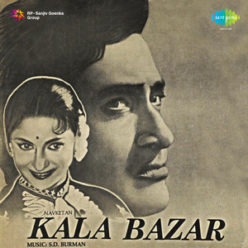
Listen HERE.
With a career spanning nearly four decades, Mohammed Rafi is one of India’s most influential musicians. Ranging from timeless Bollywood tracks to Qawwali music (a traditional form of Islamic Sufi music), to classical religious and devotional Indian music, Rafi was revered for his wide range of vocals and vocal versatility within the Indian music industry. He could also sing in multiple languages such as English, Farsi, Arabic, Sinhala, Creole, and Dutch. In 1960 the film Kala Bazar was released featuring Rafi’s song Khoya Khoya Chand, a hit single that remains a music staple among many avid listeners of Bollywood music.
2. Raja Kumari, Bindis and Bangles (2020)
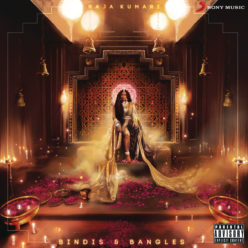
Listen HERE.
Raja Kumari is an Indian American rapper, songwriter, and singer from Claremont, California. Influenced by genres such as dance, west coast hip-hop, and rap, Kumari creates diverse and culturally hybrid tracks. Through her music, Kumari wishes to make Indian music and culture more accessible to western audiences and members of the Indian diaspora, particularly the younger generations. Kumari is also an enthusiastic Bollywood fan as seen in the artistic direction and approach of many of her music videos. From an early age, Kumari was trained in classical Indian dance and continues to incorporate these techniques into her performances and choreography. Her hit Bindis and Bangles, for instance, is a song that reflects on being rooted in tradition while looking forward to the future.
3. Cartel Madras, Goonda Gold (2019)
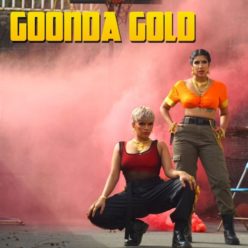
Listen HERE.
Embodying Tamil hip-hop, feminism, and reflections on diaspora, Cartel Madras is a Canadian sister duo made up of Chennai-born Eboshi and Contra. Self-identifying as queer, the two sisters strive to break the patriarchy and inspire women of colour to fight for their voices and agencies through both their music and activism. In their songs, they tackle themes of identity, diaspora, and sexuality and continuously advocate for the rights and freedoms of minority voices. They are known for their mesmerizing and fierce live performances. They recently released their latest EP “Age of the Goonda,” which features the single Goonda Gold, a song dedicated to empowering audiences within the queer and POC communities.
4. Sean Paul, I’m Still in Love with You (2002)
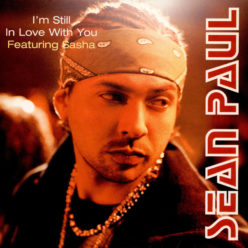
Listen HERE.
Recognized as one of the most influential pioneers of Jamaican dancehall music, Sean Paul continues to inspire and influence many listeners in the diasporas today. However, not many know that Sean Paul is not only of Jamaican descent but is also of Chinese descent on his mother’s side. With a career spanning over twenty-five years, Sean Paul has changed and innovated the genres of dancehall, reggae, hip-hop, R&B, and dance-pop. In 2002, he released his hit single I’m Still in Love with You featuring vocals by the singer Sasha. The song reached the top ten in multiple countries throughout Europe.
5. China Black, Searching (1992)
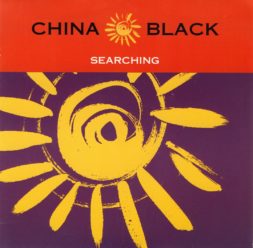
Listen HERE.
China Black was a British pop-reggae duo active during the early 1990s, consisting of songwriter, record producer, and musician Simon Fung and singer-songwriter Errol Reid. They became known for their mixing of gospel, dance, pop, and reggae beats. China Black celebrates the evolving sounds of traditional gospel choir in contrast to popular dance beats and rhythms of the time. The name China Black is a play of the band member’s heritage: Simon Fung is British Chinese and Errol Reid is of Jamaican heritage. In 1992 they released Searching which stayed number one on the reggae chart in the U.K. for consecutive twelve weeks and re-released the single in 1994 which also rounded up a successful performance in the charts. Searching continues to be a cult dance classic to many of the Asian and African diasporas residing in both North America and Europe today.
6. Lee Michelle, Without you (2014)
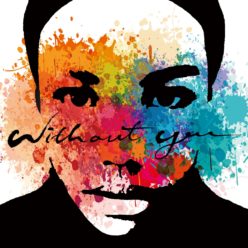
Listen HERE.
In 2011, the world was introduced to Lee Michelle, a South Korean singer born to a Korean mother and African American father, who auditioned in the first season of the South Korean reality TV competition series “K-pop Star.” Lee is recognized for her powerful voice and wide range of vocals. Throughout high school, Lee Michelle faced much racism and discrimination from her school mates due to her biracial identity. She depicts this experience of being bullied as a child in her hit single Without you from 2014. The video of this song features a young girl who plays the biographical role of Lee, who encounters racially discriminatory slurs and graffiti as well as attempts to whiten her skin in one of the scenes. Lee Michelle challenges the notion of beauty in the K-pop industry whose beauty standards are often non-inclusive and are otherwise quite commonly linked with plastic surgery and western standards of beauty.
7. Jero, Umiyuki (2008)
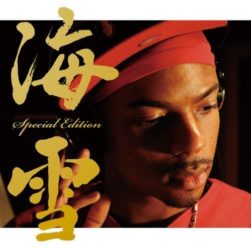
Listen HERE.
Jero is an American Enka singer of African and Japanese descent. Enka is a popular Japanese music genre that stylistically resembles traditional Japanese music. It was transformed, however, during the postwar years into a form of sentimental ballad music, considered as Modern Enka. Influenced by the Enka records of his grandmother (originally from Yokohama) Jero developed an interest in Enka and eventually moved to Japan and took part in various singing competitions. He is the first Japanese-Black singer to perform Enka in Japanese music history and has contributed to the local Tokyo and Shibuya music scenes through his combining of R&B, hip-hop, and Enka. Umiyuki, released in 2008 and reminiscent of the 1990s hip-hop and Enka, is Jero’s first single and remains a unique and beloved track in the Afro-Asian diaspora. Jero was awarded Best New Artist at the 50th Japan Record Awards in 2008.
8. Jhené Aiko, Eternal Sunshine (2014)

Listen HERE.
Jhené Aiko is an American singer and songwriter of African, Asian, Latin and European descent. Incorporating genres of psychedelic R&B, soul, and elements of electronica, Aiko composed the album “Souled Out” in 2014 which explores the story of a woman going through the cycle of heartbreak, confusion and depression before growing and gaining enlightenment from the experience. The single Eternal Sunshine from this album navigates sentimental and nostalgic moments in Aiko’s life leading up to a tragic death in her family. From using melodies of soul music to the sounds of crystals Aiko composes ambient and soothing tracks that she intends to help listeners feel a sense of healing. Aiko is seen as a pioneer as a voice of women of Afro-Asian descent in R&B.
9. Toro y Moi, Girl Like You (2017)
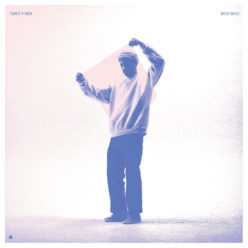
Listen HERE.
Toro y Moi is an American singer, songwriter, and record producer of mixed heritage, whose mother is Filipino, and father is of African descent. He is known for his influences over Chillwave, a music genre that emerged in the early 2000s and continues to attract avid audiences across the internet. It encompassed a dreamy retro pop sound and its signature escapist lyrics. In 2017, Toro y Moi released the single Girl Like You. Toro y Moi is popular among many of the Asian and African diasporas in North America and continues to push boundaries and experiment with the mixing of music genres, from Psychedelic rock to R&B and funk. Toro y Moi is not only a musician but also a part-time graphic designer, designing most of his album covers. His music also explores the life of being a freelancer and millennial creativity in the internet age.
10. Nujabes, Who’s Theme (2004)
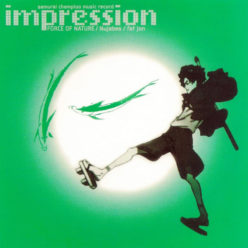
Listen HERE.
Jun Seba, also known as Nujabes, was a Japanese record producer, DJ, Composer, and arranger who mixed jazz and hip-hop samples to create his signature atmospheric hip-hop tracks. Nujabes is considered one of the pioneering godfathers of early emerging Lo-fi hip hop. One of Njuabe’s most prolific and notable works is the collaborative soundtrack with the anime hit series Samurai Champloo. An adventure Anime that is set in an alternate Edo-era anarchist Japan against the backdrop of a contemporary hip-hop soundtrack, composed by Nujabes. The track Who’s Theme featuring Japanese singer Minami was one of the soundtracks most memorable and beloved by many anime fans of the Asian diasporas. Mixing atmospheric west coast hip-hop samples with Japanese lyrics, Nujabes creates mellow, nostalgic sounds that continue to influence many Lo-fi hip hop artists.
11. Yoko Takahashi, A Cruel Angel’s Thesis (1995)
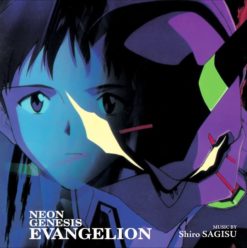
Listen HERE.
Anime is a phenomenal part of our storytelling and pop culture; what is essential to any anime is the soundtrack, which creates the ambiance and can influence millions of fans across decades. One of the most well-known opening theme songs in anime is the song A Cruel Angel’s Thesis for the series, Neon Genesis Evangelion. Combining a mix of J-pop and funk, A Cruel Angel’s Thesis was one of the first anime songs to be composed of a very philosophical use of lyrics and language. Initially, the song producers intended for the song to follow a formula more similar to classical music. However, the team changed direction while still maintaining the lyrics to better suit the mid-1990’s anime audience. The vocals were sung by Japanese singer Yoko Takahashi. Ever since the release of the song more than twenty years ago, Takahashi has influenced an ever-growing body of fandom from both Japan and the Asian diasporas. Neon Genesis Evangelion cements its status as one of the most iconic anime series with A Cruel Angel’s Thesis being one of the most sung karaoke songs of all time.
12. Kenji Kawai, Making of Cyborg (1995)
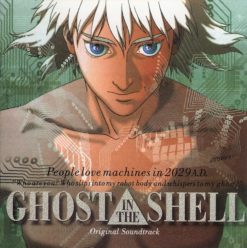
Listen HERE.
In the late 1980s Ghost in the shell made its way into pop culture through its manga series and then went on to be a well-celebrated pioneering anime in the genres of cyberpunk and science fiction. Exploring the relations between humans and technology, Ghost in the shell is revolutionary and still stands timelessly relevant thirty years from its initial release. In 1995, Japanese composer Kenji Kawai created the score Making of Cyborg. Kawai mixed classical Japanese choir with a mixture of Bulgarian sounds along with traditional Japanese instruments to create the track. Making of Cyborg has become a cult classic among many members of the Asian diasporas. It is considered one of the few songs that navigate feelings towards and fears of the future while using traditional choir and instruments to reminisce upon sentiments of the past.
13. M.I.A., Jimmy (2007)

Listen HERE.
Jimmy is a hit single by Sri Lankan British artist M.I.A., of her album “Kala” (2007). Incorporating the cover sample Jimmy Jimmy Jimmy Acha from the 1982 Film Disco Dancer. M.I.A. recalls dancing to the original 1980s track when she was a child at parties and family gatherings. Recreating this 1980s classic hit with a contemporary up-tempo twist M.I.A. arranges a mix of old Bollywood classical song styles with new waves of digital mixing.
M.I.A.’s music is rooted in the image and identity of the Sri Lankan Tamil Diaspora. She is considered a cultural innovator and continues to influence many women in the Tamil diaspora. Her music often reflects on the Sri Lankan civil war and the politics of Tamil women.
14. Raveena Aurora, Honey (2018)

Listen HERE.
Raveena Aurora is an Indian American artist and songwriter. Honey (2018) is a soft Jazz and R&B song looking into the intimate and romantic side of an underrepresented south Asian love affair. Usually overdramatized in media and Bollywood, Honey explores these concepts through a tender and contemporary lens. Growing up between Connecticut and Queens, NYC, Aurora blends R&B with classical Indian musical arrangements and sounds. Taking the lead role in directing the music video of Honey Aurora creates scenes capturing traditional Indian Jewelry, Mehendi elements, and vignettes of a couple while blending it with a combination of 1970s aesthetics. Honey, like many of Aurora’s tracks, navigates and explores themes of contemporary love, nostalgia and memories of Aurora’s childhood. Aurora is recognized among many of the Indian diasporic and queer communities for intersecting and challenging narratives of tradition, sexuality, and contemporary identities.
15. Mariya Takeuchi, Plastic Love (1984)
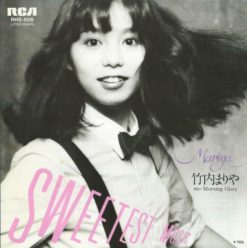
Listen HERE.
Mariya Takeuchi’s 1984 track Plastic Love went viral during the mid-2010s when it was uploaded to YouTube and popularized with music genres such as Vaporwave (a microgenre of electronic music) and 2010s internet visual culture. It is also a staple classic to Future funk, which samples the late 1970s and early 1980s Japanese City Pop, a subgenre of new wave Japanese music that came about with an emerging economy. Future funk is associated with the 1980s and 1990s anime and consumer culture and new technologies at the time such as the walkman and cassette culture. Plastic Love is considered to have reinvented itself and influenced multiple genres of music over the decades such as Funk, R&B, and Vaporwave. It continues to hold a special place in the hearts of many listeners and recording artists of the Asian Diasporas.
16. Sevdaliza, Human (2016)

Listen HERE.
Sevdaliza is an Iranian-born, Dutch-based singer and composer. Mixing genres of experimental pop, R&B, and digital avant-garde music manipulation, her music explores themes of power, melancholy, and the sexuality of women. Producing tracks in both English and Farsi, Sevdaliza’s album “ISON” follows the discovery and transformation of identity and how the world synthesizes it. Her hit single Human portrays the politics of women in relation to power structures and themes of lust and desire and how it persists in the modern world we inhabit. Incorporating the visuals of a 19th-century palace and the folklore of the minotaur, Sevdaliza takes us through the sinister nostalgia of fairy tales into the darker and cerebral elements of the contemporary woman. Sevdaliza is an inspiration to many women in the music industry today from her innovation in music to the enigmatic and powerful narratives she creates in her music videos.
17. Towa Tei’s 1994 Album “Future Listening!”
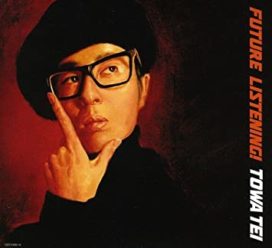
Listen HERE.
Towa Tei is an artist, record producer, and DJ, born in Yokohama Japan, and originally a member of the US pop group Deee-Lite famous for their hit single Groove Is in the Heart. He produced his debut studio album “Future Listening!” in 1994 collaborating with artists like Ryuichi Sakamoto, Joi Cardwell, and many others. In 2007, Rolling Stones Japan named “Future Listening!” number 59 on the list of “100 greatest Japanese Rock albums of all time.” Tracks like Luv Connection and Technova reached the top 30 on Billboard’s US Hot Dance Club Play in 1995. Towa Tei’s tunes continue to influence genres such as house, electronica, and Shibuya-kei today.
18. Leehom Wang, Wei Yi (2001)
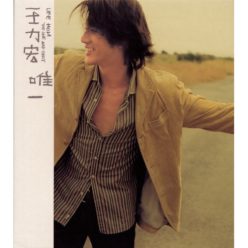
Listen HERE.
Chinese American artist Leehom Wang is a household name not only in Asia but also in the East Asian diasporas. A graduate of the Berklee College of Music, Wang’s music often embraces Western musical influences and reinvent them with added Chinese characteristics, or the other way around. His award-winning pop single, Wei Yi (meaning the one and only) from his 2001 namesake album is a romantic anthem for lovers who are not shy away from a bit of PDA. Known as a versatile talent, Wang performed the piano and violin parts of the song himself.
19. Sandy Lam, Suffer for you (1995)
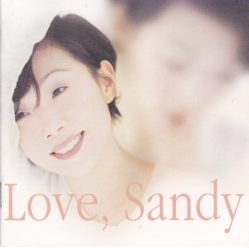
Listen HERE.
As one of the best-known Mandarin and Cantonese superstars, Hong Kong-born Sandy Lam is recognized for her decade-spanning discography of urban ballads, love songs and, more recently, experimental and electronic, R&B-inspired musical styles. Suffer for you by Lam was released as part of her 1995 album, “Love, Sandy.” Her fourth Mandarin pop album, “Love, Sandy,” was a powerful collaboration between Lam and Taiwanese music producer Jonathan Lee; it sold over 3 million copies across the Sinosphere, and it helped solidify Lam’s pop icon stature. Suffer for you, as the leading single of the ballad-filled composition, has subsequently become a smash hit and classic within the Chinese diasporas, often covered in karaoke lounges and performed in overseas Chinese concerts. The slow-paced melody depicts one’s longing for a past love that has been a lost cause.
20. Panjabi MC, Mundian To Bach Ke (1997)
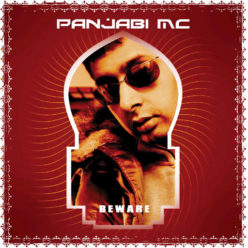
Listen HERE.
Released in 1997, Mundian To Bach Ke, also known as Beware of the Boys, became a bestselling hit in the British club scene, during the late 1990s and well into the early 2000s. Mixing hip-hop with classical Bhangra, Panjabi MC (Rajinder Singh Rai) is a British recording artist, rapper, and producer of Punjabi descent. Fusing these two genres, Panjabi MC’s tracks reflect on the hybridity of British Punjabi culture. It was re-released in 2002 featuring Jay-Z, selling an outstanding 10 million copies worldwide, making it one of the best selling singles of all time. Panjabi MC’s innovation and fusing of genres are still influential today, from the mixing of classical Indian instruments and electronica to hip-hop, Panjabi MC’s tracks remain a contemporary classic to many of the Indian diasporas. In 2008 his video Snake Charmer was screened in Toronto at the FILMI festival, North America’s longest-running South Asian film festival.
21. Yellow Magic Orchestra, Rydeen (1979)
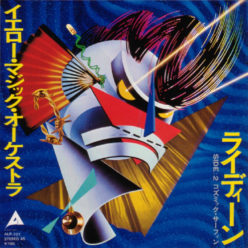
Listen HERE.
The 1980s was the beginning of an iconic era of the synthesizer, science fiction, and boom in video game culture. If there were ever a band to immerse these forms of pop culture, it would be Yellow Magic Orchestra. They are recognized as critical innovators to genres like synthpop, J-pop, and techno. Playing off the subculture of Japan’s fascination with black magic during the late 1970’s the name Yellow Magic Orchestra was formed. Combining computer technology and the synthesizer Yellow Magic Orchestra managed to create new sounds that had not occurred in contemporary music till then. The hit track Rydeen, from their 1979 album “Solid State Survivor”, to this day continues to influence video game composers and was even sampled in the soundtracks of several of SEGA’S video games, including Super Locomotive, Rabbit’s Software, and Trooper Truck. The signature element of the song was its use of samples of a running horse. YMO holds a special place in the hearts of many gamers and 1980’s enthusiasts as well as young and old of the Asian diasporas. They were considered the original cyberpunks and continue to influence us today.
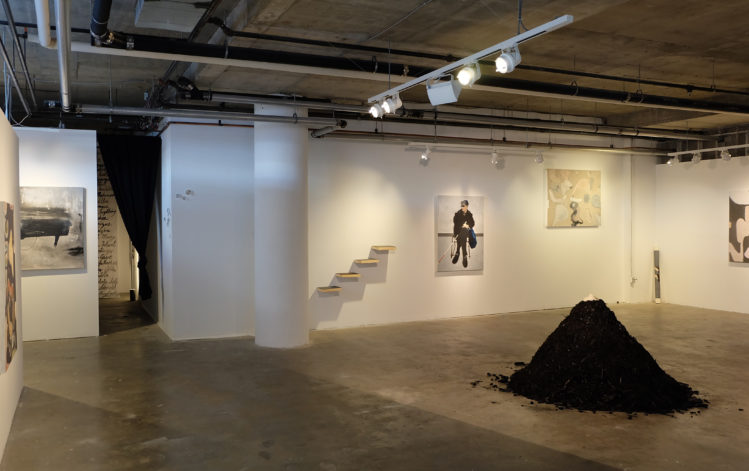
In January 2020, Vancouver-based artist and writer and Centre A’s curatorial apprentice Charisma Christal Thomas sat down with artist Lam Wong at Centre A and spoke about his artistic practice and how it was explored and introduced into his exhibition, the world is as soft as a volcano: a moving composition, at the gallery.
CCT: Hi Lam, I thought we could start this conversation learning a little about your background and how your upbringing, history and past experiences have influenced your art practice as a whole?
LW: I was born in 1968 in China, in a city called Xiamen. The year I was born was hailed as one of the most critical years for humanity. This is because all things broke loose in 1968. You know, like the man going to the moon, the Civil Rights Movement, riots in Paris, France, the assassination of Kennedy, the hippie movement, just everything. It was an important year in history and I was told that the year 2020, this year is going to be the next critical year for humanity. So that’s what the volcano piece is all about. A lot of things are just brewing and it comes to a sort of climax.
So I was born in Xiamen but my whole family immigrated to Hong Kong when I was a kid, in grade two. It was really hard at that time for any family to get out of China, but we managed somehow. My grandmother was born in Hong Kong and I think my mother was too. Anyway, there was a sort of connection to it. I basically grew up in Hong Kong. I stayed there for the next 10 years until the age of 19, and then came to Canada in 1987 with my two sisters, my mum, and my stepdad. We landed in Edmonton, Alberta in 1987. I went to high school there, my art school there and then moved to Vancouver when I turned 30, so that would be 1998. I’ve been living in North Vancouver with my wife and daughter ever since.
CCT: How do you feel these experiences have influenced your art?
LW: I don’t think that my diaspora and background really influenced my art practice. I mean this exhibition has had the most personal influence because it is about my mother, and in that sense, it is affected by the family and upbringing. But in terms of changing countries and living in different places, not exactly. I am working as a contemporary artist but the layers of meaning in my work are always informed by Eastern philosophy, especially Buddhism and Taoism. I have studied these philosophies most of my life. My work incorporates Western expressions, but the essence and soul of the work are Eastern. That’s something related to my upbringing especially because I studied Chinese first when I was younger. So I know the languages. I am fluent in those areas and am very comfortable with studying Chinese literature, especially Buddhist literature which helps my practice. Besides painting and installations, I also do tea ceremonies as performance. I use tea as a medium so I do a lot of tea-related art.
CCT: How do you explore these ideas of personal experiences and yourself in a show? How do you create? How do you take experiences and make them into art and how do you choose which narratives to portray?
LW: Well, there are a couple of approaches. Like when I have an area of interest, I’ll do research. For instance, the piano painting called CD 318 (Re-Performance); I spent months researching material for the painting and then I heard about the story of reperformance and all that [which I incorporated]. But my new series, the Free Form Biophilia series is just me throw[ing] in all the emotions. So it’s a very intuitive way to do a painting. There wasn’t any planning at all. I was explaining to Henry (Centre A’s Curator), it was kind of my way of attacking the canvas. Basically, I just have to prepare my mind into a certain space that I can paint, that I’m comfortable painting in, and once my mind was in that space, I would just take the canvas and pour myself into it. So it’s pure abstraction. I would also like thinking of them as emotions, and I am a transmitter of those emotions. So I called them “emotions under the microscope” because of what you would see through a microscope, like those kinds of amoebas and organic forms.
CCT: So, when you said that you prepare your mind before you start painting, how do you approach that, is it through meditative processes?
LW: Oh yeah, the mind has to be present and undistracted by anything. So I have this tea table in the studio where I do a bit of tea meditation. It is where I drink tea to calm down. I also have a meditation practice at home. I have a tea room that I use for tea meditation. I am also driven purely by the desire to paint. Sometimes, you just want to paint so much and in those moments you don’t want to do anything else, you just go to the studio to paint.
CCT: How do you decide which parts of your experiences you want to share with an audience? How do you navigate what you think is personal for you and what can be shared?
LW: This exhibition at Centre A deals with emotions from the most traumatic experience for me, which is losing my mother 10 years ago. She died quite tragically — falling down the stairs, 10 feet away from me. So there are a lot of heavy emotions and guilt and that is involved in that. It took me a long time. I showed Henry the painting I did of my mom a few weeks before she died. He kind of steered me into this more personal direction for the show. In terms of personal and emotional experiences, they were probably the heaviest in my life and after I lost my mom and got over that, I felt like I could do anything and nothing could be difficult anymore. Therefore it kind of fits into all these new abstraction series that I was doing about emotions.
CCT: Prior to this, did you show the work of your mother or is it something new that is being displayed for the first time?
LW: I did show it years ago in a show called “21 elements” but it wasn’t really about emotions at that time. It was more about figure paintings. My theme was about painting people in different art spaces. So this [painting of my mom] is called Blind Woman in a Photography Show, that was its context. But this show is much more about my personal struggles and it is a different context.
CCT: And working off that, thinking about working with this very personal subject matter? Is it something that is newer or different to you?
LW: This is the most personal show to date for me.
CCT: Were there difficulties that arose from that or was it something that you felt was a reflection of your work and it made sense to deliver this personal subject in this medium?
LW: I think this is a reflection of my work. It is a new approach because my other shows were much more philosophical and dealt with the notion of existence. This one does too but it is also a very direct and personal experience. The lightbox piece, for instance, called Looking at One’s Mortality, is me looking at my own death and the Volcano is a self-portrait of what is going on right now in the world, and the experience with my mother is seen in that painting [Blind Woman in a Photography Show]. So it is a new approach but I wouldn’t say it is more difficult. In a way, it was kind of liberating. I wanted to show that I can dedicate this show to my mother and describe emotions that can hopefully evoke something in the audience. Grief is a universal thing.
CCT: So do you feel that in this show, the art functions as a continuation of yourself or is it a reflection or a resolution of your problems or emotions?
LW: I feel like it is all of that together really. First of all, my art is an extension of myself. There is no question about it. It becomes a part of me and it is almost inseparable in that way. That’s just how I feel. Especially the paintings describing my own emotions. It is how I manifest into tangible artworks. I think it is all that you described.
CCT: For the exhibition itself, does it consist of past works and new works?
LW: I wanted to show the new works but what is most important to me about a show is the theme. In all my shows, I like the idea of all the individual artworks having a conversation with one another. So there are certain relationships and communications that inform each other. You then don’t see them individually, but rather as a part of something of a whole. And each one has a very special dialogue between them. These explorations are very important to me. That is my approach. So when I look at selecting the artworks, I will go to my portfolio or my collection and contemplate what should be included in the show and what works with the composition.
CCT: I know a huge part of this exhibition is that it is a “moving composition.” Do you feel that when you rearrange everything each week, it evokes different meanings or is all part of the same narrative from different perspectives, how do you think the viewer will engage with it or rather, how do you intend them to?
LW: The intention was more to do something different. To discover and surprise, was the main intention. We wanted to explore new ways of depicting and conveying meaning. Also, how the space is cut up. Space and shadow are important in my shows. All my elements also care for the shadows created. Also surprises, a lot of outcomes in the show are surprises because it depends on the space, the lighting, etc., which generate different contexts. So the rearrangement of the paintings is like that too. I think we are giving the audience different feelings and surprises.
CCT: So many people have a different dialogue with your work.
LW: Yeah, and one of the main subjects of my work is perception.
CCT: So now more to the technical side of the work, why do you choose the mediums you work in and how does that inform your art?
LW: Well, I am a painter. Whatever I am doing, painting is always essential to me. It is the heart of my practice. When I was young, I somehow knew I was always a painter. Painting has been around for ages, it is one of the most conventional mediums. So I want to create new ways of presenting paintings. I am more of an experimental painter. So even in this show, we have the painting sculpture in the corner with the feet. I just let it sit on the ground. I also built this staircase to create an emotional painting in reference to my mum and I created this sort of 3D shadow, creating metaphysical cues. I also started doing installations and performances in the last few years, which I quite enjoy! It is a way for me to directly connect with the audience.
CCT: What is the most important thing you want the audience to experience or take away from this show?
LW: My work is very existential and philosophical. One way or another, it is always about life. Whether it is about struggles or realizations, it is always about life. I think with the lightbox piece (Looking at One’s Mortality), it is very important for the audience to be aware of their own emotions and how to use intelligence and logic to understand them. Also to look at their own lives. From birth to death, that is all you get, so I would like them to use the work to contemplate about their own time and how much time we have in life, what is meaningful to them and how they are going to live it.
ABOUT THE INTERVIEWER
Charisma Christal Thomas
Charisma Christal Thomas joined the Centre A team as a curatorial apprentice under the mentorship of Centre A’s Curator, Henry Heng Lu. She is currently a fourth-year student at Emily Carr University of Art + Design where she is pursuing her Bachelor’s of Fine Arts. Thomas’s current work comprises illustration and printmaking, both of which are based in research methodologies and archival practices. With a focus on environmental sustainability rooted in a sense of place, Thomas looks for the intersection between artistic practices from her Malaysian and Indian heritage and the relationship that can be formed with nature. Her past exhibition experience include A Zine Launch Event at Access Gallery as part of Far Afield Collective and “A Clinic Unlike Any Other” a collaborative curatorial exhibition at Emily Carr University.









